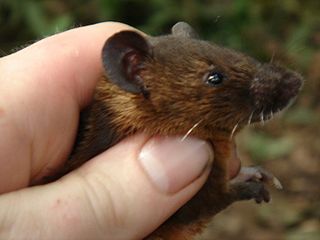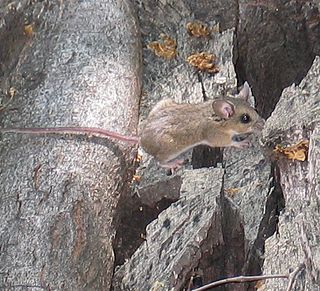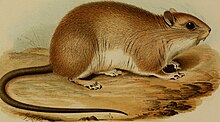
Peromyscus is a genus of rodents. They are commonly referred to as deer mice or deermice, not to be confused with the chevrotain or "mouse deer". They are New World mice only distantly related to the common house and laboratory mouse, Mus musculus. From this relative, Peromyscus species are distinguished by relatively larger eyes, and also often two-tone coloring, with darker colors over the dorsum (back), and white abdominal and limb hair-coloring. In reference to the coloring, the word Peromyscus comes from Greek words meaning "booted mouse". They are also accomplished jumpers and runners by comparison to house mice, and their common name of "deer mouse" is in reference to this agility.

The brush-furred mice, genus Lophuromys are a group of rodents found in sub-Saharan Africa. They are members of the subfamily Deomyinae, a group only identifiable through molecular analysis. Lophuromys is also known as the brush-furred rats, harsh-furred rats or coarse-haired mice.
The link rat is a species of rodent in the family Muridae. It is also known by the common name Congo forest mouse. It is native to central Africa.
The white-toothed brush mouse, also known as the white-toothed melomys or white-toothed mouse, is a species of rodent in the family Muridae. It is found only in West Papua, Indonesia. It is the only species in genus Brassomys. Its natural habitats are subtropical or tropical dry forests and subtropical or tropical dry lowland grassland.
Coccymys is a genus of rodent in the family Muridae endemic to Indonesia and Papua New Guinea. It contains the following species:
Rümmler's brush mouse or Rümmler's mouse is a species of rodent in the family Muridae. It is found in Indonesia and Papua New Guinea. Its natural habitats are subtropical or tropical moist montane forests and subtropical or tropical high-altitude grassland.
The Ethiopian forest brush-furred rat or golden-footed brush-furred rat, is a species of rodent in the family Muridae. It is endemic to Ethiopia where its natural habitat is subtropical or tropical moist montane forests. It is threatened by habitat loss.
Dieterlen's brush-furred mouse, Mt Oku brush-furred mouse, or Mount Oku brush-furred rat is a species of rodent in the family Muridae. It is endemic to Mount Oku, Cameroon. Its natural habitat is montane forest at elevations above 2,000 m (6,600 ft).
Hutterer's brush-furred mouse or Hutterer's brush-furred rat is a species of rodent in the family Muridae. It is found only in Democratic Republic of the Congo, where its natural habitat is subtropical or tropical moist lowland forests.
The Mount Cameroon brush-furred rat or Rosevear's brush-furred mouse is a species of rodent in the family Muridae. It is found only in Cameroon. Its natural habitats are subtropical or tropical moist montane forests, subtropical or tropical moist shrubland, subtropical or tropical high-altitude shrubland, subtropical or tropical high-altitude grassland, plantations, and rural gardens.

The brush mouse is a species of rodent in the family Cricetidae. It is found in mountainous areas of Mexico and the western United States at altitudes over 2,000 m (6,600 ft).

The mesquite mouse, also known as Merriam's deermouse, is a species of rodent in the family Cricetidae found in Mexico and Arizona, United States.

The white-ankled mouse is a species of rodent in the family Cricetidae. It is found in Mexico and in New Mexico, Oklahoma and Texas in the United States.

The lowland brush mouse is a species of rodent in the family Muridae. It is found in Indonesia on the island of Salawati and on the Vogelkop Peninsula in Papua Province, Indonesia.
Shaw Mayer's brush mouse is a species of rodent in the family Muridae. It is found in West Papua, Indonesia and Papua New Guinea.
The highland brush mouse, also known as the Menzies' mouse, is a species of rodent in the family Muridae. It is endemic to the New Guinea Highlands where it is found in montane moss forests and in alpine zones over 2,000 m. It is the only species in the genus Abeomelomys, although it has been placed in Pogonomelomys in the past.
The Córdoba vesper mouse or Córdoba laucha is a South American rodent species of the family Cricetidae. It is endemic to the area of Córdoba Province, central Argentina, where it is found in the espinal.

The Vogelkop–Aru lowland rain forests is a tropical moist forest ecoregion in Indonesia. The ecoregion covers the peninsular lowlands of western New Guinea, along with the Aru Islands and other nearby islands.

Hydromyini is a very large, diverse tribe of muroid rodents in the subfamily Murinae. They are the dominant native rodents in Australasia and one of only two native rodent groups there, the other being the R. fuscipes group of the genus Rattus in the tribe Rattini. They are also found in parts of Southeast Asia.
The grey pogonomelomys is a species of rodent in the family Muridae. It is found in Indonesia and Papua New Guinea.








